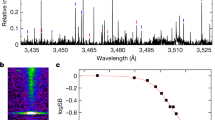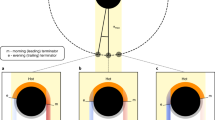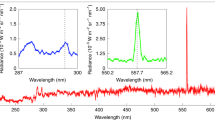Abstract
A NUMBER of teams1–3 using rocket or satellite-borne spectrometers have made observations of a group of intense unidentified emission lines in the solar spectrum between 167 Å and 220 Å. The origin and classification of these lines have aroused considerable interest in a number of laboratories. The lines were first reported from laboratory sources by Fawcett et al.4, who produced them in the Zeta discharge at Harwell. There were strong indications that iron from the walls of the discharge vessel was responsible. Further evidence for iron was provided by Elton et al.5 and House, Deutsehmann and Sawyer6, who produced the same lines by adding iron to θ-pinch discharges. Fawcett and Gabriel7 at Culham showed that the lines could be produced in various iron sparks, and also produced similar systems of intense lines from all elements in the period from calcium to nickel. From the wave number variation in these elements, they were able to state that 3p–3d transitions were responsible. By studying the intensity variation with exciting energy they obtained a correlation with ions between FeIX and FeXIII. Alexander, Feldman and Fraenkel8 observed some of these lines in several sparks of different types, and assigned degrees of ionization as FeVII to FeX. Neupert9 has made an attempt to assign ionization states by correlating the intensities from the Sun with periods of solar activity, and proposed ions between FeX and FeXIV. Zirin10 in an analysis of solar data2 has tentatively classified three lines in this spectral region as FeXIII lines.
This is a preview of subscription content, access via your institution
Access options
Subscribe to this journal
Receive 51 print issues and online access
$199.00 per year
only $3.90 per issue
Buy this article
- Purchase on Springer Link
- Instant access to full article PDF
Prices may be subject to local taxes which are calculated during checkout
Similar content being viewed by others
References
Tousey, R., Quart. J. Roy. Astro. Soc., 5, 123 (1964).
Hinteregger, H. E., Hall, L. A., and Schweizer, W., Astrophys. J., 140, 319 (1964).
Neupert, W. M., Behring, W. E., and Lindsay, J. C., Space Research IV, 719 (North Holland, Amsterdam, 1964).
Fawcett, B. C., Gabriel, A. H., Griffin, W. G., Jones, B. B., and Wilson, R., Nature, 200, 1303 (1963).
Elton, R. C., Kolb, A. C., Austin, W. E., Tousey, R., and Widing, K. G., Astrophys. J., 140, 390 (1964).
House, L. L., Deutschmann, W. A., and Sawyer, G. A., Astrophys. J., 140, 814 (1964).
Fawcett, B. C., and Gabriel, A. H., Astrophys. J., 141 (Feb. 1965).
Alexander, E., Feldman, U., and Fraenkel, B. S., Phys. Letters, 14, 40 (1965).
Neupert, W. M., I.A.U. Symp. No. 23 (1964), Ltège; Goddard Rep. X–614–64–354.
Zirin, H., Astrophys. J., 140, 1332 (1964).
Allen, C. W., Astrophysical Quantities, second ed., 43 (University of London Press, 1963).
Allen, C. W., loc. cit., 76.
Author information
Authors and Affiliations
Rights and permissions
About this article
Cite this article
GABRIEL, A., FAWCETT, B. & JORDAN, C. Classification of Iron Lines in the Spectrum of the Sun and Zeta in the Range 167 Å to 220 Å. Nature 206, 390–392 (1965). https://doi.org/10.1038/206390a0
Published:
Issue Date:
DOI: https://doi.org/10.1038/206390a0
This article is cited by
-
Solar UV and X-ray spectral diagnostics
Living Reviews in Solar Physics (2018)
-
Fusion spectroscopy
Astrophysics and Space Science (1996)
-
Role of highly-charged ions in astrophysical and laboratory plasmas
Zeitschrift f�r Physik D Atoms, Molecules and Clusters (1991)
-
The interpretation of XUV rocket measurements of intensity ratios of solar spectral lines of the lithiumlike ions O vi, Ne viii, and Mg x
Solar Physics (1972)
-
Theoretical intensities of Fexiv in the solar EUV spectrum
Solar Physics (1971)
Comments
By submitting a comment you agree to abide by our Terms and Community Guidelines. If you find something abusive or that does not comply with our terms or guidelines please flag it as inappropriate.



